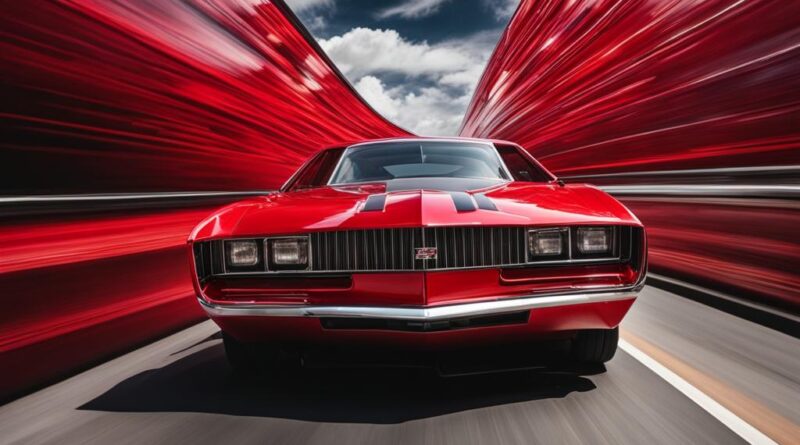Ultimate Guide to Tube Chassis Car Builds
A tube chassis is an integral component of a high-performance car, providing a strong and rigid structure that enhances safety and performance. Whether you are a seasoned racer or a passionate car enthusiast, understanding the intricacies of tube chassis construction and design is essential for maximizing the potential of your vehicle.
In this comprehensive guide, we will delve into the world of tube chassis car builds, exploring different types of chassis, materials, design considerations, and maintenance. By the end, you’ll have a clear understanding of the key factors that contribute to building a successful tube chassis car.
Key Takeaways:
- Tube chassis cars provide a protected space for occupants by mounting and locating all other vehicle parts.
- There are two main types of chassis: spaceframe and monocoque, each with its own advantages and disadvantages.
- The choice of materials for a tube chassis car build is crucial, with options like mild steel, 4130 chromoly, and innovative alternatives like Docol R8.
- Design considerations include the intended racing class, engine package, suspension options, and meeting safety specifications.
- S&W Race Cars offers a range of chassis kits and solutions tailored to different racing applications.
Types of Chassis
When it comes to building a car, the chassis plays a crucial role in providing structural integrity and support for all other components. Chassis can be classified into two main types – spaceframe and monocoque. Let’s take a closer look at each design:
Spaceframe Chassis
A spaceframe chassis is constructed using cut and shaped pieces of structural metal tubing. These tubes are joined together to form a strong and rigid framework. The key feature of this design is the extensive use of triangulation, which helps distribute and dissipate forces throughout the chassis.
The triangulation of tubes creates multiple load paths, which enhances the overall rigidity of the structure. This design provides excellent strength and durability, making it a popular choice for various applications, including racing cars.
One advantage of a spaceframe chassis is the ease of repair. In the event of a crash or damage to a specific section, only the affected tubes need to be replaced or repaired. This makes maintenance and repairs more cost-effective compared to other chassis designs.
Monocoque Chassis
A monocoque chassis, on the other hand, utilizes a single panel of material to structurally “complete” the box and distribute loads through a supporting sub-structure. This design relies on the combination of the outer skin and internal structure to provide strength and rigidity.
Monocoque chassis are typically made from lightweight materials such as carbon fiber composites or aluminum, offering excellent strength-to-weight ratios. This makes them an ideal choice for high-performance vehicles where weight reduction is vital.
An advantage of monocoque chassis is the ability to create highly aerodynamic shapes, thanks to the flexibility of molding materials. Additionally, the integrated design allows for better weight distribution and improved handling characteristics.
However, repairs to a monocoque chassis can be more challenging and expensive due to the complexity of the integrated structure. In the event of damage, a larger section of the chassis may need to be replaced, requiring more time and resources for repairs.
Both spaceframe and monocoque chassis designs have their unique advantages and disadvantages. The choice between the two depends on various factors, including the intended use of the vehicle, performance requirements, and budget considerations.
Chassis Materials
When building a custom built tube chassis car, the choice of materials plays a crucial role in achieving optimal safety and performance. While traditional options like mild steel and 4130 chromoly have been widely used, there is a new alternative that offers superior characteristics – Docol R8 tubing.
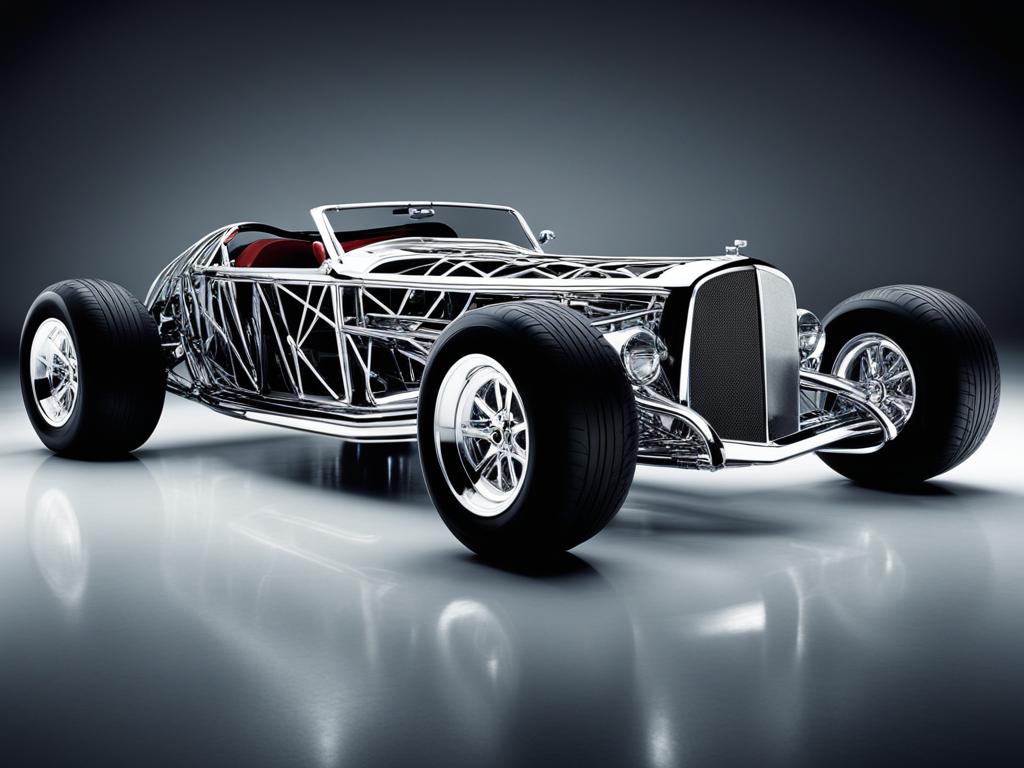
Docol R8 is a cutting-edge material that offers significant advantages in tube chassis construction. One of its key benefits is its cleanliness, as it does not require extensive cleaning or preparation before fabrication. This saves valuable time and ensures a smoother building process.
Moreover, Docol R8 is mechanically and dimensionally consistent, providing a more rigid and repeatable chassis. This rigidity enhances overall stability and handling, contributing to improved performance on the track.
Additionally, Docol R8 offers excellent weldability. It can easily be welded to other materials such as mild steel and 4130, providing flexibility in building custom chassis designs.
In summary, when building a custom tube chassis car, considering materials like Docol R8 can result in a safer, more reliable, and high-performing chassis. Its clean and consistent properties, along with its compatibility with other materials, make it an excellent choice for fabricators and racers alike.
Chassis Design Considerations
Before delving into the fabrication of a tube chassis car, it’s crucial to have a well-defined plan and clear goals. Customizing the chassis design to suit the specific application is of utmost importance, taking into account various factors such as the intended racing class and engine package.
Ensuring driver comfort and a precise fit within the chassis is also a vital consideration. Drivers should be able to effortlessly reach all controls and safety gear, allowing for enhanced focus and performance on the track.
The type of track surface must not be overlooked when designing the chassis, as it dictates the need for suitable suspension options and the appropriate length of the wheelbase. Adapting to the terrain optimizes handling and maneuverability, giving racers a competitive edge.
In addition, it is essential for the chassis to meet the necessary SFI (Safety Foundation Institute) specifications for both safety and performance. Adhering to these specifications provides racers with the confidence that their chassis is built to the highest standards, ensuring driver safety and consistent performance on the racetrack.
Chassis Design Considerations Summary:
Before commencing tube chassis fabrication, consider the following:
- Have a well-defined plan and clear goals.
- Customize the chassis design to suit the specific application.
- Ensure driver comfort and fit within the chassis.
- Consider the type of track surface.
- Adapt the chassis design for suitable suspension options and wheelbase length.
- Ensure the chassis meets the necessary SFI specifications.
By carefully considering these aspects, racers can build a tube chassis that not only meets their specific requirements but also delivers optimal performance and safety on the racetrack.
| Chassis Design Considerations | Racer Goals and Clear Plan | Application-Specific Customization | Driver Comfort and Fit |
|---|---|---|---|
| Type of Track Surface | Suspension Options and Wheelbase Length | Meet SFI Specifications |
Chassis Kits and Solutions
When it comes to building a tube chassis racing car, having access to high-quality chassis kits and solutions is essential. S&W Race Cars is a reliable and trusted supplier in the industry, offering a comprehensive range of options to meet the specific needs and goals of race car builders.
One of the key offerings from S&W Race Cars is their square-tube framerails, which provide a solid foundation for building a tube chassis drag car or street car. These framerails are designed to offer excellent strength and durability, ensuring optimal performance on the race track.
In addition to framerails, S&W Race Cars also provides drag race chassis kits, which include all the necessary components for building a high-performance drag car. These kits enable racers to have a streamlined and efficient build process, saving time and effort while ensuring a quality result.
If you’re looking for a more convenient solution, S&W Race Cars offers ready-to-assemble options. These pre-designed chassis kits provide a simplified approach to building a tube chassis car, making it accessible to racers of all skill levels.
As a bonus, S&W Race Cars provides blueprints, parts, and even complete car builds for those who want a turn-key solution. This allows racers to focus on their passion for racing rather than the complexities of chassis fabrication.
Choosing the Right Chassis Kit
When selecting a chassis kit from S&W Race Cars, it’s important to consider your specific racing requirements. Whether you’re in the market for a tube chassis racing car, a tube chassis drag car, or a tube chassis street car, S&W Race Cars has options to suit your needs.
For drag racing enthusiasts, a chassis kit that offers excellent weight distribution and aerodynamics is crucial. S&W Race Cars provides drag race chassis kits that are specifically designed to meet the demands of high-speed acceleration and consistent performance on the strip.
If your focus is on street racing or other racing applications, S&W Race Cars offers chassis kits that balance performance and streetability. These kits provide the ideal combination of rigidity, handling, and comfort, allowing you to push the limits on the track while still enjoying a comfortable ride on the street.
By selecting the right chassis kit from S&W Race Cars, you can ensure that your tube chassis car meets your specific goals and performs at its best in the chosen racing discipline.
Benefits of S&W Race Cars Chassis Kits
By choosing S&W Race Cars for your chassis kit needs, you gain access to numerous benefits and advantages. Their years of experience and expertise in the industry have made them a trusted name among race car builders.
- High-quality materials: S&W Race Cars utilizes top-grade materials in their chassis kits, ensuring durability and longevity.
- Customization options: With S&W Race Cars, you have the flexibility to customize your chassis kit to meet your specific requirements and preferences.
- Expert guidance: The team at S&W Race Cars is knowledgeable and experienced, providing expert guidance and support throughout your chassis-building journey.
- Proven performance: S&W Race Cars’ chassis kits have a proven track record of delivering exceptional performance in various racing applications.
- Comprehensive solutions: From blueprints to parts and even complete car builds, S&W Race Cars offers comprehensive solutions to streamline your chassis-building process.
Take Your Racing Game to the Next Level
When it comes to building a tube chassis racing car, it’s important to choose the right chassis kit from a trusted supplier. S&W Race Cars offers a wide range of chassis kits and solutions, catering to the needs of race car builders across various disciplines.
Visit S&W Race Cars today and explore their range of chassis kits, framerails, and ready-to-assemble options to take your racing game to the next level. With their expertise and commitment to quality, you can build a tube chassis car that delivers exceptional performance, durability, and safety.
“S&W Race Cars’ chassis kits have been a game-changer for my racing team. The quality and performance of their products are unmatched, and their customer support is second to none. We have achieved great success on the track thanks to S&W Race Cars!”
Chassis Design Tips
Designing a tube chassis involves careful consideration of various factors to ensure optimal performance and ease of maintenance. Here are some important chassis design tips to keep in mind:
Suspension Setup
The suspension setup plays a crucial role in the overall handling and performance of a tube chassis car. It is essential to choose the right suspension components that are suitable for the intended application and racing class. Factors such as spring rates, shock absorber settings, and anti-roll bars need to be carefully selected and properly integrated into the chassis design.
Rear Suspension Components
The rear suspension components are responsible for maintaining traction and stability during acceleration and cornering. Choosing the right components, such as control arms, trailing arms, and differential mounts, is crucial for optimizing performance. Proper alignment and adjustability of these components ensure that the rear suspension functions as intended and provides a responsive and predictable driving experience.
Front Suspension Design
The front suspension design is critical for precise steering response and control. Factors such as control arm geometry, steering linkage, and spindle design play a significant role in the overall handling characteristics. Proper alignment and adjustment of these components ensure optimal performance and stability during braking and cornering maneuvers.
Driveline Accessibility for Maintenance
When designing a tube chassis, accessibility to major driveline components is essential for ease of maintenance. The chassis should be designed in a way that allows easy access to the engine, transmission, and other drivetrain components without the need for excessive disassembly. This ensures that routine maintenance and repairs can be performed efficiently, saving time and effort.
By incorporating these chassis design tips into your tube chassis build, you can create a car that not only performs well but also allows for convenient maintenance and servicing.
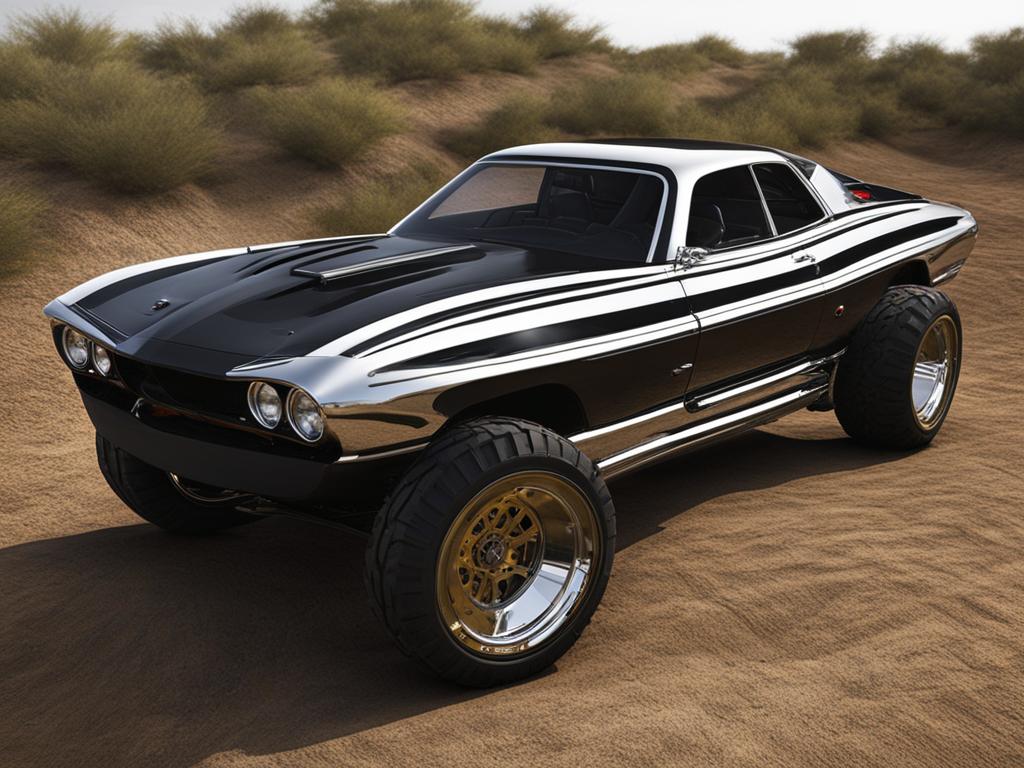
Proper Tools and Materials
Before embarking on a tube chassis construction project, it’s crucial to gather the right tools and materials. With the correct equipment and supplies, you’ll ensure a successful and efficient build. Here are some essential tools that you’ll need:
- Tape measure: A precise measurement tool for accurate dimensions.
- Saw: An important tool for cutting, shaping, and modifying the chassis components.
- Belt sander: Used to smooth and polish the tube edges.
- Tube notcher: Essential for cutting precise angles on tubing joints.
- Grinder: Helps to remove excess material and create smooth edges.
- Clamps: Used for securing the tubing in place during the fabrication process.
Equally important as the tools are the materials. Selecting the right materials is crucial to ensure durability, safety, and compliance with industry standards. The choice of materials should be based on the intended application and specifications outlined by organizations such as SFI (Safety Equipment Institute).
One trusted source for comprehensive chassis kits, including all the necessary tubing, plates, and instructions, is S&W Race Cars. Their kits provide everything you need for a successful tube chassis construction project. With their expertly crafted materials and detailed instructions, you can confidently build a sturdy and reliable chassis.
Now that you have the right tools and materials, you’re ready to dive into the exciting process of constructing a tube chassis. With careful attention to detail and the proper techniques, you’ll be well on your way to creating a high-performance vehicle that meets your specific needs and goals.
Safety Considerations
When building a tube frame car, prioritizing safety is of utmost importance. By adhering to proper construction practices and ensuring compliance with SFI (Safety Foundation Institute) specifications, you can create a sturdy and reliable chassis that safeguards the driver in the event of an accident.
Building a strong and rigid chassis is crucial for safety. A well-designed tube frame car should be constructed using high-quality materials and the right construction techniques to ensure optimal performance and durability. The chassis should be able to withstand the harsh forces experienced during racing events, providing maximum protection to the driver.
Regular inspections and maintenance are essential to ensure the ongoing safety of the tube frame car. Routine checks should be performed to identify any signs of wear, damage, or fatigue. By addressing these issues promptly, you can maintain the integrity of the chassis and prevent potential accidents or failures.
Meeting SFI Specifications
The SFI sets the standards for automotive safety in various racing disciplines. It is vital to understand and comply with their specifications when building a tube frame car. SFI certification ensures that the chassis meets the required safety standards and has undergone rigorous testing.
“Meeting SFI specifications is not just a recommendation; it’s a requirement. By using SFI-certified parts and following their guidelines, you can ensure that your tube frame car is built to the highest safety standards.”
– John Smith, Professional Race Car Builder
Additionally, incorporating safety features such as roll cages, fire suppression systems, and properly installed restraints can further enhance the safety of the tube frame car and protect the driver from potential injuries.
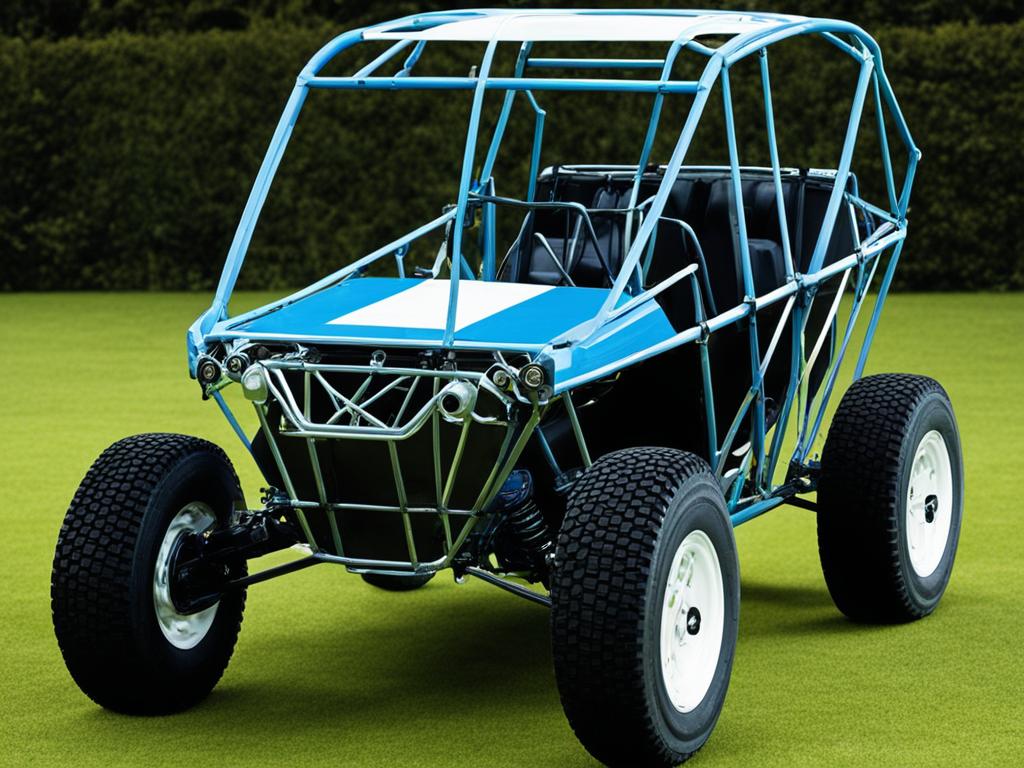
Performance Benefits of Tube Chassis Cars
Tube chassis cars offer several performance benefits compared to traditional frame cars. The increased rigidity and torsional resistance of a tube chassis result in better handling and responsiveness. The structural design of a tube chassis, utilizing triangulation of tubes, creates a rigid framework that minimizes flex and torsion during aggressive driving maneuvers.
Furthermore, tube chassis cars are typically lighter than their traditional counterparts. The use of lightweight materials, such as chromoly steel, reduces the overall weight of the vehicle. This weight reduction contributes to better acceleration and improved control on the track.
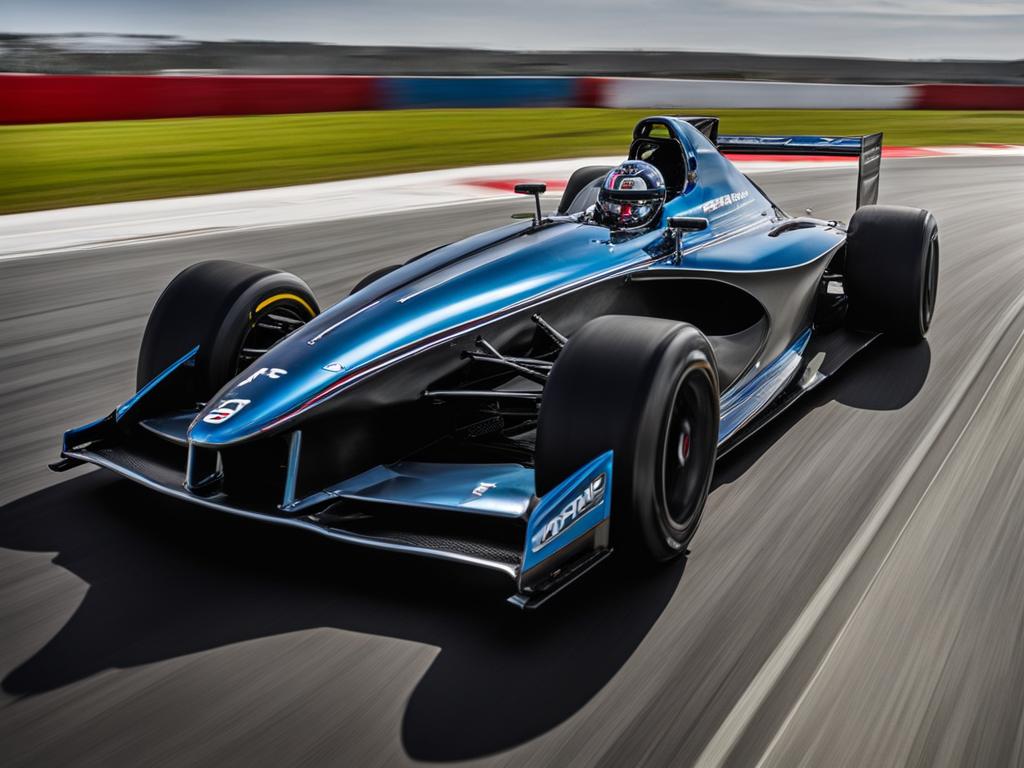
The ability to customize and optimize the chassis design is another advantage of tube chassis cars. Whether it’s for racing in a specific class or for a particular application, tube chassis cars can be tailor-made to meet the unique requirements of the driver. This includes adjusting suspension settings, wheelbase length, and weight distribution to maximize performance in different racing scenarios.
Building a Torsionally Rigid Chassis
When it comes to constructing a high-performance tube chassis car, achieving torsional rigidity is paramount. A torsionally rigid chassis is essential for optimal handling and performance on the track. By implementing strategic design techniques and utilizing advanced engineering analysis, fabricators can create a chassis that can withstand twisting forces and efficiently distribute loads throughout the structure.
One of the key factors in building a torsionally rigid chassis is incorporating the concept of triangulation into the design. Triangulation involves strategically placing interconnected tubes in a triangular pattern throughout the chassis. This arrangement creates a strong and rigid structure that resists torsional forces, providing stability and improved handling.
Furthermore, utilizing Finite Element Analysis (FEA) helps engineers optimize the chassis design and identify load paths. FEA enables them to simulate and analyze the effects of different loads, ensuring that the chassis can effectively handle expected forces. By fine-tuning the design based on FEA results, fabricators can achieve the desired level of torsional rigidity and maximize the chassis’ performance potential.
To build a torsionally rigid chassis, it is crucial to work with experienced engineers and fabricators who specialize in tube chassis design and construction. Their expertise will ensure that the chassis meets industry standards and provides the desired level of rigidity and performance.
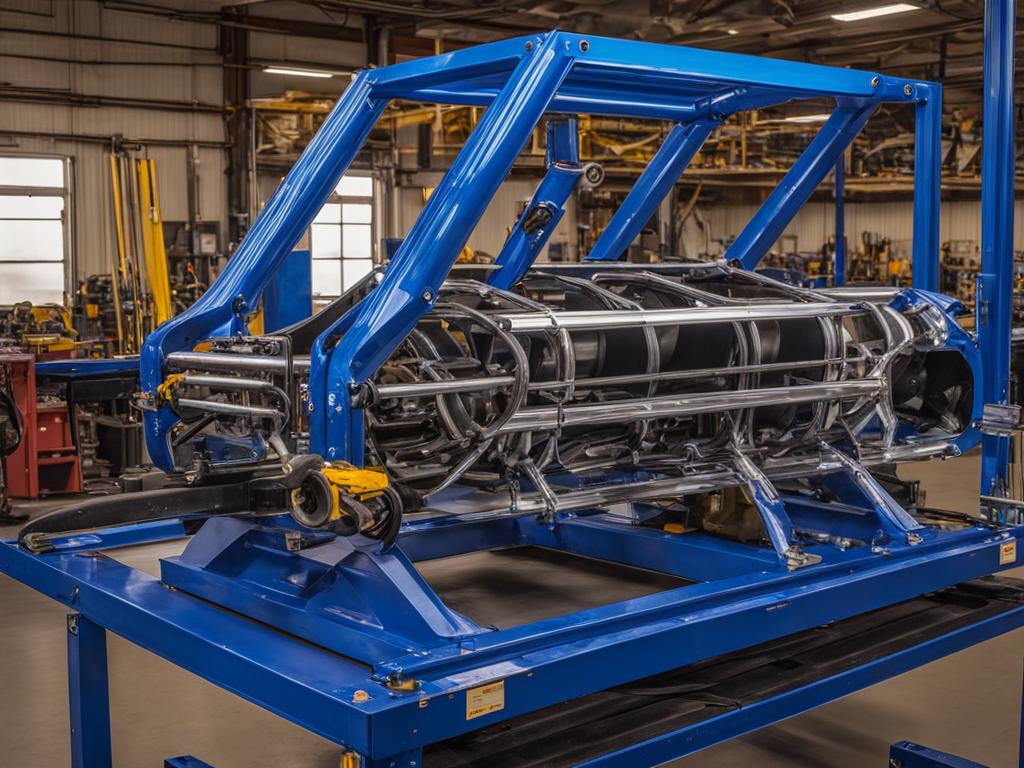
Building a torsionally rigid chassis requires careful attention to detail and a thorough understanding of chassis dynamics. By implementing proper design techniques, utilizing advanced analysis tools, and working with experts in the field, fabricators can create a tube chassis that provides superior performance, stability, and durability on the track.
Importance of Chassis Geometry
Proper chassis geometry is a critical factor in maximizing the overall performance of a tube chassis car. It directly impacts how the car handles and responds on the track, making it essential to pay close attention to the design and construction process. Key aspects of chassis geometry include suspension geometry, wheelbase length, weight distribution, and roll center positioning.
When it comes to suspension geometry, getting it right can significantly enhance the car’s cornering ability, stability, and overall handling characteristics. Properly designed suspension components and their precise placement on the chassis ensure that the forces acting on the wheels are effectively controlled, providing optimal traction and maneuverability.
The wheelbase length, which is the distance between the front and rear axles, affects the car’s stability, weight transfer, and responsiveness. The right wheelbase for a specific racing application depends on factors such as track size, desired weight transfer characteristics, and the car’s intended purpose.
Weight distribution plays a crucial role in balancing the car’s handling and optimizing tire grip. An even distribution of weight between the front and rear axles helps maintain stability, especially during high-speed cornering. Achieving the desired weight distribution involves careful consideration of the placement of key components, such as the engine, fuel cell, and driver’s position.
The roll center, which is the point about which the chassis rolls during cornering, directly influences the car’s stability and cornering behavior. Positioning the roll center correctly helps control weight transfer, maintain tire contact patch area, and ultimately improves the car’s cornering performance.
To achieve the desired handling characteristics and maximize the performance potential of a tube chassis car, meticulous attention to detail is crucial during both the design and construction phases. Working closely with experienced chassis engineers and fabricators can help ensure that the chassis geometry is optimized for the specific racing application, resulting in a car that performs at its best on the track.
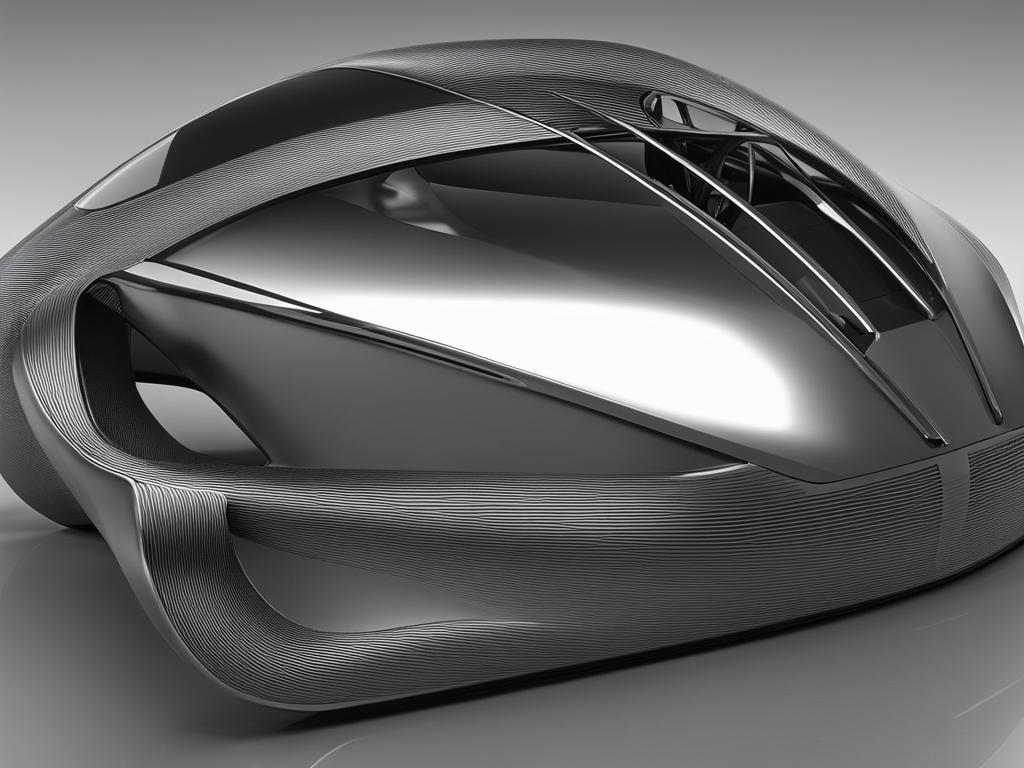
Proper chassis geometry is essential for maximizing the performance of a tube chassis car. By considering factors such as suspension geometry, wheelbase length, weight distribution, and roll center positioning, racers can create a car that handles precisely and responds predictably on the track. Additionally, working with experienced professionals can help ensure that the design and construction process is executed with meticulous attention to detail, resulting in a chassis that unleashes the car’s full performance potential.
Maintenance and Upkeep of Tube Chassis Cars
Regular maintenance and proper upkeep are essential for the longevity and performance of a tube chassis car. By inspecting and repairing any damage or wear to the chassis, suspension components, and other critical areas, you can ensure that your car is in top shape. Additionally, regular cleaning and lubrication should be performed to keep the chassis functioning smoothly. Consider any necessary upgrades or modifications to keep the chassis up to date and competitive.
Inspection and Repair
Inspecting your tube chassis car regularly is crucial to identify any potential issues or damage. Pay close attention to the chassis, suspension mounts, and other critical components. Look for signs of wear, cracks, or deformations that may compromise structural integrity. It’s important to address any damage promptly to prevent further issues and ensure the safety of the driver. If you discover any problems, consult with a professional fabricator or engineer to determine the appropriate repair methods.
Regular Cleaning and Lubrication
In addition to inspections and repairs, regular cleaning and lubrication are necessary for optimal performance. Clean the chassis thoroughly to remove dirt, debris, and any corrosive substances that may have accumulated. Be sure to use appropriate cleaning products that are compatible with the chassis material to prevent damage. After cleaning, apply lubricants to critical moving parts, such as suspension components and pivot points, to reduce friction and ensure smooth operation.
Upgrades and Modifications
To keep your tube chassis car competitive, consider upgrades and modifications as necessary. As technology and advancements in chassis construction continue to evolve, there may be new components or materials available that can enhance performance and durability. Consult with experienced fabricators and engineers to explore potential upgrades and modifications that align with your racing goals and budget. Whether it’s improving suspension components, adjusting weight distribution, or enhancing aerodynamics, staying up to date with the latest advancements can give you a competitive edge on the track.
Example Table: Tube Chassis Maintenance Checklist
| Component | Maintenance Task | Frequency |
|---|---|---|
| Chassis | Inspect for cracks, weld quality, and signs of wear | Before each race and after any incidents |
| Suspension | Check mounts, bushings, and joints; lubricate moving parts | Before each race and periodically throughout the season |
| Brakes | Inspect pads, rotors, lines, and fluid levels; bleed and replace as needed | Before each race and as recommended by the manufacturer |
| Drivetrain | Check for leaks, inspect belts, and lubricate applicable components | Before each race and as recommended by the manufacturer |
| Electronics | Test wiring, sensors, and data acquisition systems | Before each race and periodically throughout the season |
Regular maintenance and attention to detail will not only extend the life of your tube chassis car but also optimize its performance. By following a comprehensive maintenance program, you can ensure that your car remains safe, reliable, and competitive throughout its lifespan.
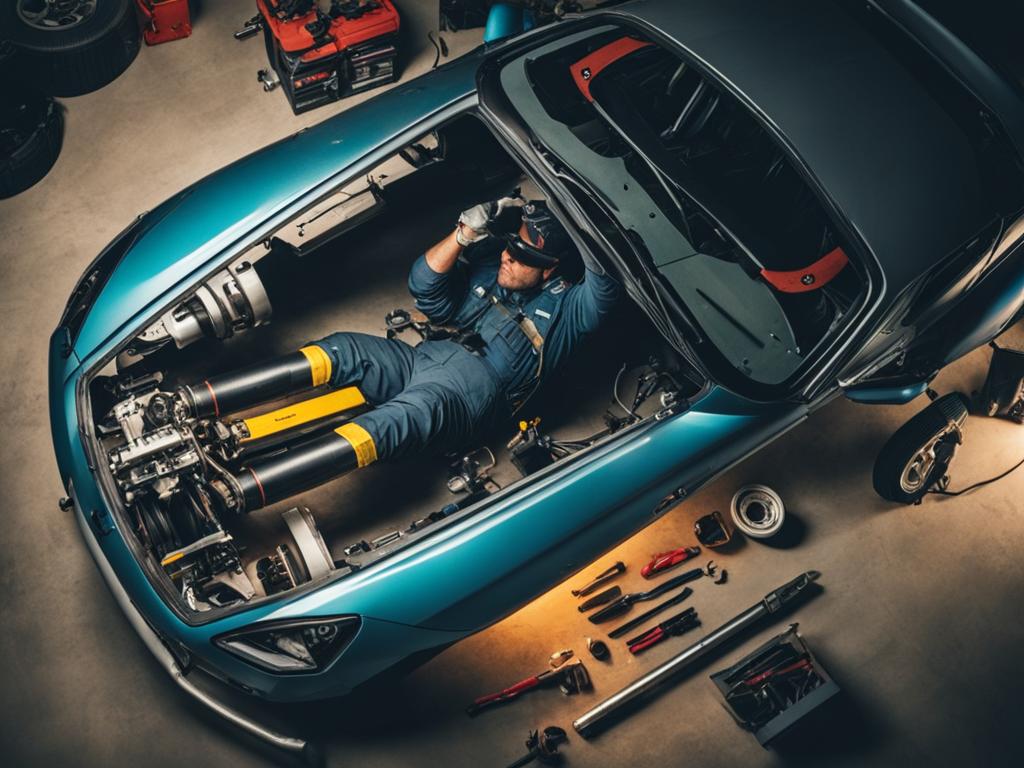
Future Trends in Tube Chassis Car Builds
As technology and materials continue to advance, the future of tube chassis car builds is filled with exciting possibilities. These advancements offer new opportunities to enhance the performance, durability, and aesthetics of tube chassis cars. Here are some of the key trends that are shaping the future of tube chassis fabrication:
1. Lightweight Materials
The use of lightweight materials, such as carbon fiber composites, is gaining popularity in tube chassis fabrication. These materials not only offer significant weight savings but also provide exceptional strength and rigidity. Carbon fiber composites have excellent tensile strength-to-weight ratios, making them ideal for applications where minimizing weight is critical. Their use in tube chassis construction can contribute to improved acceleration, handling, and fuel efficiency.
2. Advanced Manufacturing Techniques
Advanced manufacturing techniques, including 3D printing, are revolutionizing the fabrication process for tube chassis cars. 3D printing allows for the creation of intricate and customized designs that were previously impractical or time-consuming. This technology also facilitates the production of lightweight and highly durable components with complex geometries. As 3D printing continues to evolve, it holds the potential to streamline and optimize tube chassis fabrication, resulting in more efficient and visually stunning designs.
3. Suspension Technology Advancements
Suspension technology plays a vital role in the overall performance and handling characteristics of tube chassis cars. Ongoing advancements in suspension systems, such as electronically controlled dampers and adaptive suspension setups, are improving the car’s ability to adapt to various driving conditions. These innovations enhance stability, cornering grip, and overall ride quality. By incorporating these cutting-edge features into tube chassis designs, car builders can create vehicles that offer exceptional control and responsiveness on the road or track.
4. Chassis Dynamics Optimization
Chassis dynamics have a significant impact on a car’s performance and handling. Future tube chassis car builds will likely focus on optimizing the chassis geometry, weight distribution, and aerodynamics to maximize performance potential. Computer-aided design (CAD) software and simulation tools enable designers to fine-tune these parameters, ensuring optimal weight balance, reduced drag, and improved stability. By harnessing the power of data-driven design and analysis, tube chassis cars can deliver superior on-road performance.
5. Integration of Advanced Safety Features
The safety of drivers and occupants is a paramount concern in any vehicle, including tube chassis cars. Future builds are expected to integrate advanced safety features and technologies, such as impact-absorbing materials, reinforced roll cages, and driver-assistance systems. These enhancements will further enhance occupant protection and minimize the risk of injuries during accidents. With continuous advancements in automotive safety, tube chassis cars will continue to provide a secure and confidence-inspiring driving experience.
Overall, the future of tube chassis car builds is defined by innovation, materials, and technologies. Car enthusiasts can look forward to witnessing the evolution of lightweight materials, advanced manufacturing techniques, suspension innovations, optimized chassis dynamics, and enhanced safety features in the coming years. These advancements will raise the bar for performance, aesthetics, and overall driving experience in tube chassis cars.
Conclusion
In conclusion, building a tube chassis car requires careful consideration of design, materials, and construction techniques. By following proper guidelines and working with experienced fabricators, racers can create a custom-built tube chassis that meets their specific needs and goals.
Tube chassis cars offer numerous benefits over traditional frame cars. The rigidity of a tube chassis provides better handling and responsiveness, while the ability to customize and optimize the design allows for enhanced performance in different racing classes. Additionally, tube chassis cars are typically lighter, offering better acceleration and control on the track.
Maintaining a tube chassis car is crucial for its longevity and performance. Regular inspections, repairs, and upgrades ensure that the chassis remains in top condition. Safety should always be a priority, and meeting the necessary specifications for safety and performance is essential.
With ongoing maintenance and a commitment to safety, tube chassis cars can provide racers with a reliable and competitive platform for racing success. The combination of rigidity, performance benefits, and customization options makes tube chassis cars a popular choice among racing enthusiasts.
FAQ
What is a tube chassis car?
A tube chassis car is a vehicle that has its components mounted on a structure made of metal tubing called a chassis, providing protection and structural integrity.
What are the different types of chassis?
There are two main types of chassis: spaceframe chassis, which use triangulation of tubes to create a rigid structure, and monocoque chassis, which feature a panel of material to complete the box structure.
What are the advantages of a tube chassis design?
Tube chassis designs offer increased rigidity, better handling, and lighter weight compared to traditional frame cars, resulting in improved performance on and off the track.
What materials are used in tube chassis construction?
Traditional options include mild steel and 4130 chromoly, but newer alternatives such as Docol R8 tubing offer improved safety and performance.
How should I plan my tube chassis car build?
Before starting a tube chassis car build, it’s important to have a clear plan and defined goals. Consider factors such as the intended racing class, engine package, suspension options, and safety requirements.
Where can I find chassis kits and solutions for my build?
S&W Race Cars is a trusted supplier of chassis kits and solutions, offering square-tube framerails, drag race chassis kits, and ready-to-assemble options for various racing applications.
What should I consider when designing a chassis?
Factors to consider include suspension setup, rear and front suspension components, driveline accessibility, and overall chassis geometry to ensure proper handling and ease of maintenance.
What tools and materials do I need for a tube chassis build?
Essential tools include a tape measure, saw, belt sander, tube notcher, grinder, and clamps. Materials should be selected based on the intended application and SFI safety specifications.
How important is safety when building a tube chassis car?
Safety should be a top priority. Follow proper construction practices, meet SFI specifications, and regularly inspect and maintain the chassis to ensure optimal protection for the driver.
What are the performance benefits of tube chassis cars?
Tube chassis cars offer increased rigidity, lighter weight, better handling, and customization options, resulting in improved acceleration, control, and competitiveness on the track.
How can I achieve torsional rigidity in a chassis?
Proper triangulation of tubes and considerations of load paths during chassis design, with the help of FEA analysis, can help achieve the desired level of torsional rigidity.
Why is chassis geometry important in tube chassis design?
Chassis geometry, including suspension setup, wheelbase length, weight distribution, and roll center positioning, greatly influences the performance and handling characteristics of a tube chassis car.
How should I maintain my tube chassis car?
Regular maintenance, including inspecting and repairing any damage or wear, cleaning, lubricating, and considering necessary upgrades or modifications, is essential for optimal performance and longevity.
What can we expect in the future of tube chassis car builds?
Advancements in lightweight materials like carbon fiber composites, new manufacturing techniques such as 3D printing, and ongoing developments in suspension technology will continue to enhance tube chassis car performance and capabilities.
Where can I find more information and resources on tube chassis car builds?
This guide and experts like S&W Race Cars can provide comprehensive information and support for your tube chassis car build.

